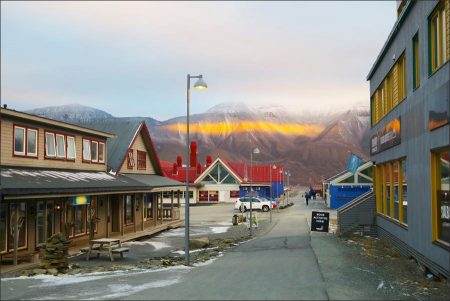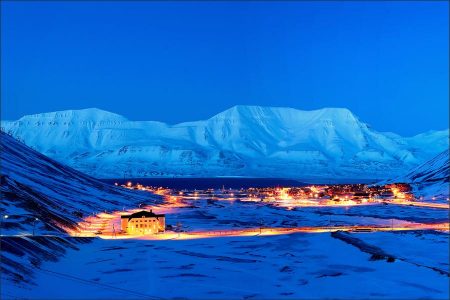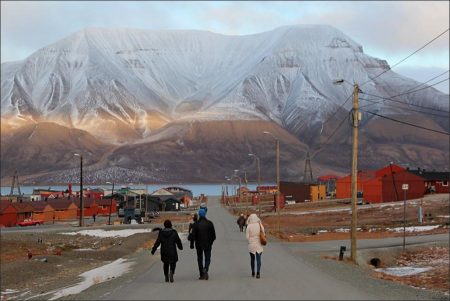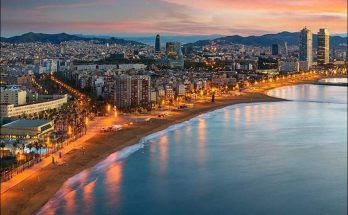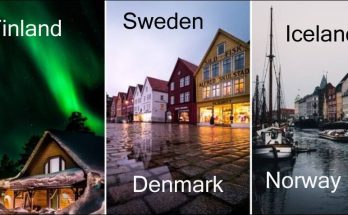Approaching the Norwegian archipelago of Svalbard is like crossing some unseen frontier of the mind. Jagged natural ramparts, serpentine fjords and vast ice sheets stretch to the horizon, seemingly to the ends of the earth.
Depending on the capricious whims of the extreme Arctic climate and calendar, thick clouds reveal remote fragments of the landscape as if concealing some great mystery, blinding sunshine illuminates the ice, or perpetual moonlight bathes it all in the strange, blue half-light of the polar night. In Svalbard, life is reduced to some of its most stirring elements, in the process evoking the Arctic North of popular imagination.
Deep inside the Arctic Circle, far closer to the North Pole than to Oslo, Svalbard is at once one of Europe’s last intact wilderness areas and the world’s most accessible slice of the polar North. It is also one of the natural world’s grand epic landscapes. Sixty percent of Svalbard’s territory is covered by glaciers. More polar bears (around 3,000) inhabit the land here than people (around 2,500). And for four months of the year (from 20 April to 21 August), the sun rarely nears the horizon and never sets, even as the sun is absent entirely for the four-month night (26 October to 16 February) when the Aurora Borealis dances across the sky.
For all the magic inherent in Svalbard’s vital statistics, the main settlement of Longyearbyen speaks powerfully of humankind’s troubled relationship with the Arctic environment. Across town, the abandoned detritus of an industrial past and the ugly scars of the coal mines that still drive the archipelago’s economy sit uneasily against the backdrop of a pristine wilderness protected by some of the world’s strictest environmental legislation.
Wild reindeer, Arctic fox and polar bear are a regular presence in the town’s hinterland, even as Svalbard is littered with reminders of the hunting expeditions which for centuries drove many Arctic species to the brink of extinction. Such juxtapositions tell the story of humanity’s best and worst impulses brought to bear upon an environment which may be irrevocably altered within our lifetimes.
To make the long journey to Svalbard – there are daily SAS flights throughout the year from Oslo and / or Tromsø – and restrict yourself to Longyearbyen would be akin to journeying to the Sahara and taking nothing more than a sunset camel trip out into the dunes.
Fortunately, Svalbard is one of Europe’s most exhilarating destinations for adventure-based tourism. The list of year-round activities on offer – the Svalbard tourist office has a comprehensive list, as well as a booking facility – includes hiking, glacier walks, kayaking and boat excursions that last a day or ten in summer, or dog-sledding and snowmobiling in winter. While these may have a certain appeal in and of themselves, the real attraction of these activities is as a means for exploring the inner and uninhabited reaches of Svalbard, a territory with less than 50km of roads.
Leaving behind the modern world and heading out into the deep Arctic in the company of a team of huskies, watching for polar bears as you race through isolated valleys astride a snowmobile, hiking high onto the ice sheet for sweeping views in the ringing silence: these are the iconic Svalbard experiences that transport you into the Arctic that you thought existed only in the imagination.
And as ever in the Arctic, exploring Svalbard beyond its somewhat scruffy settlements carries strong echoes of the past. Svalbard once stood on the outermost limits of the known world and was a launching pad for some of the more picaresque tales of polar exploration. While the perils of traversing Svalbard may have diminished in equal measure to the increase in comfort levels for those who venture out onto the ice, the inspiration for coming here remains largely unchanged: to immerse yourself in a frozen wilderness and discover the true frontier spirit of the polar north.
Visits: 84
